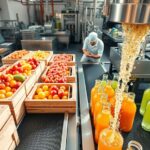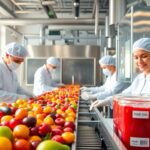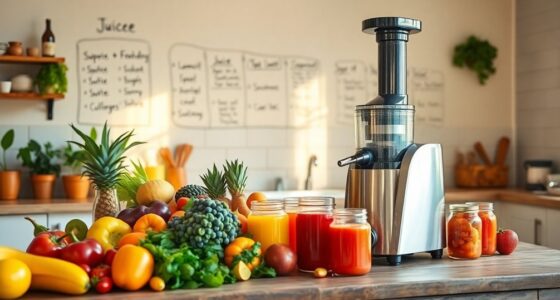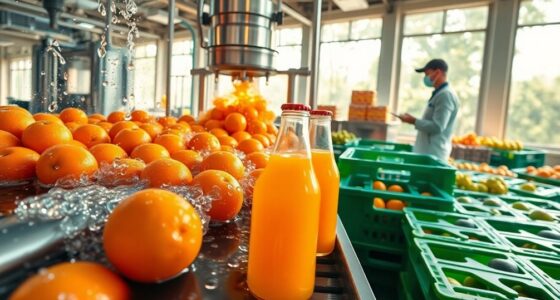To ascertain juice quality, start with selecting high-quality, organic raw materials from trusted farms. Use proper processing techniques like washing, extraction, and pasteurization to maintain purity and taste while following safety regulations. Implement rigorous quality assurance testing, from pH levels to third-party evaluations, to guarantee consistency. By addressing challenges like contamination and managing additives, you can build consumer trust. Discover more steps to enhance your juice quality throughout the manufacturing process.
Key Takeaways
- Prioritize sourcing raw materials from sustainable, organic farms to ensure high-quality and flavorful juice.
- Implement rigorous quality inspections and testing at every stage, from raw material selection to final product.
- Utilize proper processing techniques, including thorough washing, effective extraction, and filtration, to maximize yield and purity.
- Ensure compliance with safety regulations and maintain accurate labeling for transparency and consumer trust.
- Regularly monitor and adapt quality control measures to address contamination risks and evolving industry standards.
Raw Material Selection

When selecting raw materials for juice production, you must prioritize quality to guarantee purity and taste.
Start by sourcing from reliable, sustainable farms that practice organic farming. This not only enhances the flavor profile but also supports environmental sustainability.
Timing is vital; ideal harvesting secures fruits are at the correct ripeness, maximizing their natural taste.
Implement a rigorous quality inspection process, including visual checks for damage and disease. Chemical analysis is fundamental to detect contaminants, securing juice purity and adherence to safety standards.
Building strong relationships with farmers can lead to a consistent supply of high-quality produce, necessary for maintaining your brand's reputation in the juice industry.
Quality raw materials are the foundation for excellent juice production.
Processing Techniques

To guarantee high-quality juice, implementing effective processing techniques is essential right after the raw materials are selected. Start with proper washing to remove contaminants, guaranteeing juice purity. Next, choose the right extraction process—whether pressing, crushing, or grinding—to maximize yield while minimizing unwanted components. Filtration processes follow, producing clear juice while retaining beneficial fibers.
Pasteurization is a critical step to eliminate harmful microorganisms and extend shelf life. Regular monitoring of these steps acts as quality control measures to maintain juice purity and nutritional value, guaranteeing consumer safety.
| Process | Purpose |
|---|---|
| Washing | Removes dirt and contaminants |
| Extraction | Maximizes yield; minimizes unwanted parts |
| Filtration | Produces clarity; retains fibers |
| Pasteurization | Guarantees safety; extends shelf life |
Safety Regulations

Assuring juice safety goes beyond just the production process; it involves strict compliance with national and international food safety standards.
You must adhere to regulations concerning hygiene, pesticide limits, and contaminants to guarantee quality and safety for consumers. Regular audits help confirm that your operations meet these safety protocols, as any non-compliance can result in legal repercussions and product recalls.
Accurate labeling is critical too, providing ingredient lists, nutritional information, and allergen warnings for consumer transparency.
Implementing robust traceability systems allows you to track raw materials from their source to the final product, facilitating quick identification of contamination sources.
Quality Assurance and Testing

Quality assurance and testing are critical components in the juice manufacturing process, as they help guarantee that every bottle meets high standards for safety and taste. You'll engage in rigorous testing, from pH measurements to microbiological testing, ensuring your juices remain high quality. Quality control measures, like visual inspections and raw materials analysis, eliminate sub-standard ingredients. Third-party testing provides an independent evaluation, confirming compliance with safety regulations. Continuous monitoring allows you to adjust processes based on testing results, maintaining consistency and brand reputation. Additionally, ensuring that juices are rich in vitamins A, C, and E can further enhance their appeal and health benefits.
| Testing Type | Purpose | Frequency |
|---|---|---|
| In-house Testing | Measure pH, acidity, sugar | Every batch |
| Microbiological Testing | Detect harmful microorganisms | Weekly |
| Third-party Testing | Independent evaluation | Monthly |
| Quality Control | Inspect raw materials | Per shipment |
Challenges in Juice Production

While juice production can yield delicious and healthy beverages, several challenges threaten the process. Contamination risks during harvesting, transportation, and storage can greatly compromise juice quality and safety.
You’ll need robust quality management systems to guarantee that your juice meets the required standards. The use of additives in juice production, if not managed correctly, can undermine purity and erode consumer trust. Implementing stringent quality control in juice manufacturing is essential to ensure that every batch adheres to safety and quality regulations. Regular testing and monitoring throughout the production process can help identify and eliminate any potential contaminants or inconsistencies. By prioritizing these practices, companies can not only enhance the integrity of their products but also build lasting relationships with their customers based on transparency and trust.
Cross-contamination in facilities challenges your efforts to maintain consistent juice quality. Additionally, compliance with evolving regulations demands your ongoing attention and adaptation.
Achieving customer satisfaction requires meticulous quality checks and continuous improvement throughout production. By addressing these challenges, you can enhance the overall juice quality and guarantee a product that consumers can trust and enjoy. Incorporating nutrient-dense ingredients into your juice formulations can further elevate the health benefits and overall appeal of your products.
Frequently Asked Questions
How Do You Ensure Quality in Manufacturing?
To guarantee quality in manufacturing, you need to implement a robust Quality Management System (QMS).
Regularly conduct in-house and third-party testing to monitor critical parameters like pH and sugar content.
Inspect raw materials upon delivery to catch any sub-standard ingredients early.
Stay compliant with food safety standards to protect consumer health.
Finally, provide continuous training for your team on quality protocols to foster a culture that prioritizes excellence in every step of the process.
What Is the Manufacturing Process of Juice?
You know what they say: "You reap what you sow."
In juice manufacturing, it starts with selecting quality fruits or vegetables. After washing and sorting, you peel and cut them for extraction, using methods like pressing or grinding.
You then filter out pulp and seeds for a smooth consistency. Finally, you pasteurize the juice to eliminate harmful microorganisms, ensuring it's safe and extends shelf life before packaging for consumers.
What Is the QA Process in Manufacturing?
The QA process in manufacturing guarantees products meet standards and customer expectations.
You'll start with raw material inspections, followed by rigorous testing at various production stages.
It's vital to comply with industry regulations and follow a robust Quality Management System.
Employee training plays a significant role, as trained staff will correctly follow procedures.
Continuous improvement comes from monitoring processes and collaborating with suppliers to maintain raw material quality.
How Does Quality Assurance Ensure Quality During Production?
Imagine a well-oiled machine, each cog smoothly turning to maintain quality.
Quality assurance guarantees consistency during production by implementing rigorous checks at every stage. You monitor raw materials, conduct tests for acidity and sugar content, and inspect microbial activity.
By collaborating with reliable suppliers and training employees regularly, you create a robust framework that detects issues early, guaranteeing that the final product meets safety and quality standards.
Your attention to detail keeps quality at the forefront.
Conclusion
In the quest for high-quality juice, every step counts—from selecting the best raw materials to implementing rigorous safety regulations. By prioritizing effective processing techniques and robust quality assurance, you can truly elevate your juice production. So, why settle for anything less than perfection when you can guarantee every sip is bursting with flavor and safety? With dedication to these practices, you're not just making juice; you're creating a delightful experience for every consumer.
Cindy thoroughly researches juicing trends, techniques, and recipes to provide readers with practical advice and inspiration. Her writing style is accessible, engaging, and designed to make complex concepts easy to understand. Cindy’s dedication to promoting the advantages of juicing shines through her work, empowering readers to make positive changes in their lives through the simple act of juicing.
















